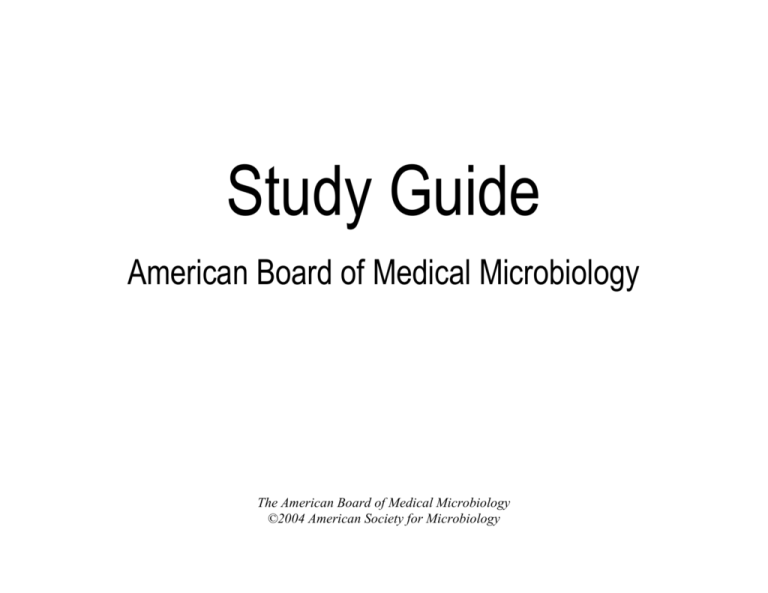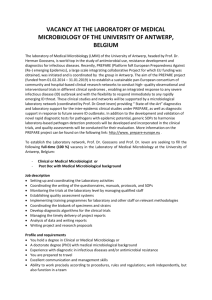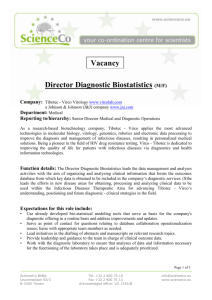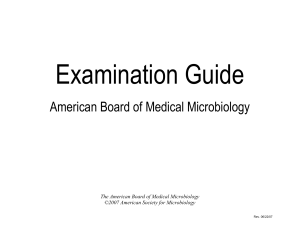Study Guide 092004 - American Society for Microbiology
advertisement

Study Guide American Board of Medical Microbiology The American Board of Medical Microbiology ©2004 American Society for Microbiology Study Guide C. Examination Content The content of the examination will be distributed as follows: EXAMINATION FORMAT A. Objective To measure the candidate’s knowledge in the five subject areas considered necessary for the effective practice of clinical or public health microbiology: 1. 2. 3. 4. 5. Bacteriology, including mycobacteriology. Mycology. Virology. Parasitology. Miscellaneous, including microbial genetics, laboratory safety and biohazard management, laboratory operation and management, cost accounting, preparation of dilutions or media, infection control, and serology. B. Examination Administration 1. The examination will be administered the Saturday preceeding the American Society for Microbiology General Meeting. 2. Proctors will supervise the examination. Candidates are allowed 6 hours in which to complete the examination, beginning at 9:00 a.m. and concluding at 4:00 p.m. This time frame allows for a 1-hour supervised break. The time allotted is considered to be much greater than that required for answering the questions, but the Board does not wish time constraints to be a factor in performance. 3. Bring several #2 lead pencils and a legal document with your photograph and signature to the examination. Acceptable legal documents are a driver’s license, government identification card, passport, or notarized photograph bearing your signature. 4. Reference materials and calculators are not permitted. 2 Subject area % Examination Bacteriology Mycology Parasitology Virology Universal 40–50 15–20 10–15 15–20 5–10 D. Question Format and Content 1. Each question is multiple choice, with only one correct answer. 2. Questions have four or five possible responses. 3. In some cases, questions may require calculations. Examples include assessment of sensitivity, specificity, antimicrobial concentrations, dilution factors, and cost accounting results. 4. Approximately 60% of the questions test for basic recall of knowledge, direct interpretation of data, or simple synthesis of information. The remaining 40% of the questions require a higher level of thought process, reasoning skills, or interpretation of data. 5. Questions are updated and evaluated every year. Candidates can expect to see questions on technical advances or microbiological issues that occurred during the past year. 6. There is no penalty for guessing; only correct answers are graded. 7. Questions in the content areas of bacteriology, mycology, parasitology, and virology cover six areas: (a) diagnostic systems and interpretation of laboratory data, (b) public health, (c) infection control, (d) molecular biology, (e) infectious disease and pathogenesis, and (f) universal. Suggested study topics are listed below; however, test questions may not be limited to these topics. a. Diagnostic Systems and Interpretation of Laboratory Data i. Sensitivity, specificity, and predictive value of positive and negative test results. Know the formulas for these characteristics of diagnostic assays and how to interpret them on the basis of actual data. ii. The principles and details of performance of commonly used and newly accepted assay systems, including antigen detection, direct fluorescentantibody stains, enzyme-linked immunosorbent assays (ELISAs), nucleic acid hybridization and amplification, and cultures. Be able to determine which methods are superior in specific circumstances. iii. Proper and appropriate specimen collection and transport, tailored for specific disease processes. iv. Automated blood culture systems, identification systems, and antimicrobial susceptibility test systems—how they work and the kinds of technical problems associated with their use. b. Public Health i. How to handle an outbreak of any communicable disease, including the appropriate specimens to collect and to whom they should be sent. ii. Recommended immunizations, when to give them, and populations for which each vaccine is efficacious. iii. Serologic tests useful for epidemiological versus diagnostic studies (fungal serologies, for example). iv. Centers for Disease Control and Prevention (CDC)mandated reportable diseases and reportable isolates, including case definitions. c. Infection Control i. Proper protocols for handling infected employees, patients with communicable diseases, and laboratory exposures to infectious agents. ii. Standard, contact, and airborne precautions, as well as other types of isolation as they pertain to specific infectious disease situations. iii. Infection control measures to practice in the case of exotic or new hemorrhagic fevers or other communicable diseases that were previously limited to geographically isolated areas. iv. Serologic tests recommended for employees, immunocompromised patients, and other groups at risk for acquiring infections. v. Biohazard classifications, waste disposal, and laminar flow hood use. vi. Other issues of laboratory and hospital biological safety. d. Molecular Biology i. The principles and performance of polymerase chain reaction (PCR) and other nucleic acid amplification procedures, DNA homology studies, DNA probe tests, and new molecular methods (such as restriction fragment length polymorphism and ribotyping) and their use in diagnosis and epidemiology. ii. The principles and performance of plasmid analysis and other molecular epidemiological methods. iii. Basic concepts, use of different markers, and technical performance information on the probebased commercial products used in diagnostic microbiology. iv. The molecular basis for the common mechanisms of antimicrobial resistance. 3 e. Infectious Disease/Pathogenesis i. ii. iii. iv. v. vi. vii. viii. ix. f. Modes of actions of antibiotics, toxicities, and mechanisms of resistance. Suitability of antibiotics for specific infectious processes (for example, those that penetrate the cerebrospinal fluid [CSF] and might be useful for treatment of meningitis, those used for treatment of common diseases, and those used as antivirals and antifungals). Disease processes and pathogenesis and diagnostic strategies for infectious diseases based on signs and symptoms. Specimens appropriate for the diagnosis of infectious disease, based on the disease process. General patterns of susceptibilities for microorganisms with predictable patterns. Antimicrobial susceptibility testing and interpretations, quality control practices, and NCCLS guidelines. Serologic responses to common infections for which serology is the main diagnostic tool, such as hepatitis, Epstein-Barr virus (EBV), syphilis, human immunodeficiency virus (HIV) disease, brucellosis, toxoplasmosis, parvovirus, and other viral infections. Life cycles of parasites as they pertain to diagnostic testing and infectious stages. Staining characteristics of pathogenic microbes. Universal i. ii. Shipping and mailing etiologic agents. Decision-making strategies for choosing a test method. iii. Personnel and legal issues associated with directing a laboratory. 4 iv. General aspects of laboratory safety (for example, working with radioactive compounds, earthquakeproofing equipment, and electrical precautions). v. Quality control and quality assurance activities. vi. Federal regulations governing laboratories, including the Clinical Laboratory Improvement Amendments (CLIA), the U.S. Occupational Safety and Health Administration (OSHA), and the Joint Commission on Accreditation of Healthcare Organizations (JCAHO). E. Recent examinees identified the following activities as most beneficial for examination preparation: 1. Studying from established references and clinical microbiology texts, such as the American Academy of Pediatrics Red Book, Control of Communicable Diseases Manual, Biosafety in Microbiological and Biomedical Laboratories, Principles and Practice of Infectious Diseases, and ASM’s Manual of Clinical Microbiology. (Full references are listed following this section.) 2. Reviewing recent issues of Morbidity and Mortality Monthly Report (MMWR) and Clinical Microbiology Newsletter, American Society for Clinical Pathology (ASCP) Check Sample exercises, NCCLS guidelines, and review articles. 3. Discussing examination-type problems and being quizzed by mentors. 4. Working in those areas of the laboratory where the candidate may be less familiar. 5. Attending infectious disease rounds. F. Scoring 1. The examination answer sheets are scored electronically. Scores within five (5) points of the passing score are verified by hand. 2. The ABMM uses a criterion-referenced scoring system. This method sets a standard of performance in absolute, not relative, terms. As a result, candidates are not graded on a curve and do not compete against each other. Each question is rated individually by its relative difficulty and scored according to a standard of performance predetermined by a consensus of the examination committee. Thus, if more difficult questions are chosen for a particular examination, the passing score will be lower than that of another examination of equal length but with easier questions, as determined by the committee. Each candidate’s score is based only on the number of correct answers; there is no comparison among candidates. 3. After the examination has been scored, the examination committee evaluates the responses. Occasionally, questions fail to perform as expected and are dropped from the scoring and the examinations are rescored. 4. Examination results are mailed to candidates within 10 to 12 weeks. Results are not released by telephone. References Chin, J. (ed.). 2000. Control of communicable diseases manual, 17th ed. American Public Health Association, Washington, D.C. Mandell, G. L., J. E. Bennett, and R. Dolin (ed.). 2000. Mandell, Douglas, and Bennett’s principles and practice of infectious diseases, 5th ed. Churchill Livingstone. Murray, P. R., E. J. Baron, M. A. Pfaller, F. C. Tenover, and R. H. Yolken (ed.). 2003. Manual of clinical microbiology, 8th ed. ASM Press, Washington, D.C. Pickering, Larry K. (ed.). 2003. Red book: report of the Committee on Infectious Diseases, 26th ed. American Academy of Pediatrics, Elk Grove, Ill. Richmond, J. Y., and R. W. McKinney (ed.). 1999. Biosafety in microbiological and biomedical laboratories, 4th ed. U.S. Department of Health and Human Services, Centers for Disease Control and Prevention, and National Institutes of Health. U.S. Government Printing Office, Washington, D.C. SAMPLE QUESTIONS 1. In cases of possible sexual abuse involving children, the identification of oxidase-positive, gram-negative diplococci such as Neisseria gonorrhoeae requires: A. demonstration of acid production from glucose and maltose. B. a positive direct immunofluorescent reaction with monoclonal antibody against N. gonorrhoeae outer membrane protein. C. a positive particle agglutination using monoclonal antibody to N. gonorrhoeae. D. identification of N. gonorrhoeae by two distinct methodologies. Question tests Bacteriology: Diagnostic Systems and Interpretation of Laboratory Data. 2. A 6-year-old near-drowning victim is admitted to a pediatric hospital’s intensive care unit and placed on a respirator. Seven days after admission, he develops pneumonia. A Gram-stained smear of aspirated tracheal secretions reveals the presence of many polymorphonuclear cells and many intracellular gramnegative diplococci. The MOST probable identity of this organism is: A. B. C. D. Moraxella catarrhalis. Aeromonas hydrophila. Neisseria meningitidis. Chromobacterium violaceum. Question tests Bacteriology: Diagnostic Systems and Interpretation of Laboratory Data. 5 3. Five cases of prosthetic valve endocarditis caused by Staphylococcus epidermidis are observed in one hospital. Of the following available methods, which is BEST for determining whether all five isolates were derived from a single source? A. B. C. D. Serotyping Plasmid fingerprinting Antimicrobial susceptibility testing Bacteriophage typing Question tests Bacteriology: Molecular Biology. 4. Which of the following organisms is the most common cause of septicemia in patients with sickle cell disease? A. B. C. D. Salmonella enteritidis Streptococcus pneumoniae Streptococcus agalactiae Shigella sonnei 6. The highly infectious asexual conidia of Coccidioides immitis are called: A. B. C. D. arthroconidia. blastoconidia. chlamydospores. sporangiospores. Question tests Mycology: Public Health. 7. Which of the following specimens is the most sensitive for the diagnosis of infections with Naegleria fowleri? A. B. C. D. Brain tissue Corneal scraping CSF Urine Question tests Parasitology: Diagnostic Systems and Interpretation of Laboratory Data. Question tests Bacteriology: Infectious Disease/Pathogenesis. 5. F.D. was generally healthy until his impacted wisdom tooth was removed by an oral surgeon. The area where the tooth had been was sore, but what was more alarming was the appearance of eruptions through the skin beneath the area of the jaw where the tooth had been. The exudate draining through the skin eruptions was cultured aerobically, but the results were negative. Of the following, the MOST likely etiologic agent would be: A. B. C. D. Actinomyces israelii. Histoplasma capsulatum. Nocardia asteroides. Actinomyces bovis. Question tests Bacteriology: Infectious Disease/Pathogenesis. 6 8. An individual who has received all three doses of hepatitis B vaccine and who has never had hepatitis B virus (HBV) infection would be expected to have which of the following serologic marker(s)? A. B. C. D. HBcAb HBsAb HBeAb HBeAb and HBsAb Question tests Virology: Diagnostic Systems and Interpretation of Laboratory Data. 9. Which of the following laboratory tests offers the greatest value for predicting the therapeutic efficacy of nucleoside analogues as an initial treatment for an HIV-infected individual? A. B. C. D. Enumeration of CD4+ lymphocytes HIV genotype analysis Measurement of HIV RNA levels in plasma Measurement of p24 antigen levels in serum 12. Which of the following respiratory viruses is a nonenveloped virion? A. B. C. D. Rhinovirus Parainfluenza virus Respiratory syncytial virus (RSV) Coronavirus Question tests Virology: Molecular Biology. Question tests Virology: Diagnostic Systems and Interpretation of Laboratory Data. 10. Which one of the following viral diseases has the SHORTEST incubation period? A. B. C. D. Rubella Influenza Hepatitis A Hepatitis B 13. To safely work with etiologic agents classified as Biosafety Level 2 (BSL 2) requires BSL 1 laboratory practices, equipment, and facility recommendations. An additional recommendation is to: A. B. C. D. perform all procedures within a Class II biosafety cabinet. wear gloves and face protection for potential splashes only. have negative air flow from the hallway to the laboratory. have self-closing double-door access. Question tests Universal. Question tests Virology: Public Health. 11. A 56-year-old male is admitted with rapidly progressive dementia and ataxia. A diagnosis of Creutzfeldt-Jakob disease is made. The patient should be placed on which of the following precautions? A. B. C. D. Droplet isolation Airborne isolation Standard precautions No isolation Question tests Virology: Infection Control. 14. A patient who recently returned from a camping trip in Montana is hospitalized with high fever and prostration that recurs every 5 to 7 days. Loosely coiled spiral-shaped organisms 10 to 20 mm in length are noted in a Wright-stained smear of the patient’s blood. The organism is most probably: A. B. C. D. Leptospira interrogans. Spirillum minor. Borrelia parkeri. Treponema pallidum. Question tests Bacteriology: Diagnostic Systems and Interpretation of Laboratory Data. 7 15. At laboratory rounds, the supervisor shows you the following susceptibility results by microbroth dilution of a Streptococcus mitis isolate from a patient with endocarditis: penicillin resistant, erythromycin resistant, and vancomycin susceptible. The physician telephones asking for the susceptibility results, including susceptibility to clindamycin. What should you tell the physician? A. None of the susceptibility results are ready to be reported until confirmed by a second antimicrobrial susceptibility test (AST) method, but viridans group streptococci remain predictably susceptible to clindamycin. B. Report the current results, and advise him that viridans group streptococci remain predictably susceptible to clindamycin. C. Report the current results, and advise him that in viridans group streptococci, resistance to erythromycin predicts resistance to clindamycin. D. Report the current results, and tell him the laboratory will also test the isolate for susceptibility to clindamycin. Question tests Bacteriology: Diagnostic Systems and Interpretation of Laboratory Data. 16. A previously normal, full-term infant developed bilateral conjunctivitis at 2 weeks of age. The conjunctivitis was followed by severe coughing, but the infant remained afebrile. When the infant was 4 weeks old, a chest X ray showed bilateral symmetrical interstitial infiltrates. The white blood cell (WBC) count was 14,000/mm3 with 32% segmented neutrophils, 58% lymphocytes, 2% monocytes, and 4% eosinophils. Serum immunoglobulin G (IgG), IgA, and IgM levels were elevated. The MOST probable agent is: A. B. C. D. Chlamydia trachomatis. Streptococcus agalactiae. Haemophilus influenzae. adenovirus. Question tests Bacteriology: Infectious Disease. 17. Two days after a 51-year-old man suffered a puncture wound to his thumb while fishing in the Gulf of Mexico, he experienced the abrupt onset of pain, fever, and rapidly progressing skin lesions on both lower extremities. Subsequent symptoms included tingling in the hand, nausea, vomiting, fever, and chills. On admission to the hospital, he had purpuric skin lesions on both legs. Blood cultures obtained at the time of admission demonstrated growth of gram-negative bacteria. This infection was MOST likely caused by: A. B. C. D. Vibrio damsela. V. metschnikovii. V. vulnificus. V. parahaemolyticus. Question tests Bacteriology: Infectious Disease. 8 18. Two patients were admitted to a major medical center in the southwestern United States. The first patient presented with chronic sinusitis. Hematoxylin and eosin stains of debrided material revealed granulation tissue, chronic inflammation, and noninvasive, brownish septate hyphae. The second patient presented with leukemia and an erythematous cutaneous lesion. Biopsy of the lesion revealed septate hyphae, swollen hyphal elements, and hyphae with bizarre dilatations. The MOST probable etiology for both patients is: A. B. C. D. Aspergillus species. Rhizopus species. Bipolaris species. Drechslera species. Question tests Mycology: Diagnostic Systems and Interpretation of Laboratory Data. 19. A previously healthy, 24-year-old Mexican immigrant is brought to an emergency room in Los Angeles because of seizures. A computerized axial tomography (CAT) scan reveals a solitary calcified lesion, 2 cm in diameter, in the right cerebral hemisphere. The MOST probable diagnosis is: A. B. C. D. central nervous system (CNS) coccidioidomycosis. cerebral cysticercosis. cerebral echinococcosis. extraintestinal amebiasis. Question tests Parasitology: Infectious Disease. 20. A 17-year-old male presented to an emergency room with a genital lesion. A swab taken from the lesion produced herpeslike cytopathic effect in primary human amnion cells. However, attempts to pass the virus or confirm the presence of herpes antigens by direct fluorescent-antibody techniques were unsuccessful. Electron photomicrographs of the original specimen subsequently revealed the presence of poxviruses. Based on this information, the patient most probably has: A. B. C. D. shingles. orf disease. molluscum contagiosum. whitepox. Question tests Virology: Diagnostic Systems and Interpretation of Laboratory Data. 21. A patient develops a new respiratory infiltrate and becomes febrile. After primary routine culture of expectorated sputum has been evaluated and results have not been helpful, the next test likely to yield the most diagnostic information with the least patient risk is: A. B. C. D. bronchoalveolar lavage. fine-needle aspiration. thoracentesis. open-lung biopsy. Question tests Universal. 22. Several laboratory tests were researched for their usefulness in evaluating suspected histoplasmosis in patients who reside in an area where this disease is endemic. If the prevalence of histoplasmosis is 25%, which of the following sensitivity and specificity combinations would you choose as the MOST useful confirmatory test for DIAGNOSING the disease? A. B. C. D. Sensitivity of 50%, specificity of 98% Sensitivity of 90%, specificity of 80% Sensitivity of 92%, specificity of 70% Sensitivity of 99%, specificity of 90% Question tests Universal. 9 ANSWERS 1. 2. 3. 4. 5. 10 D A B B A 6. 7. 8. 9. 10. A A B B B 11. 12. 13. 14. 15. C A B C D 16. 17. 18. 19. 20. A C C B C 21. A 22. A






